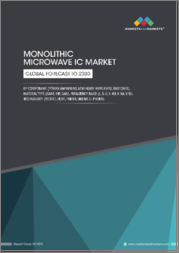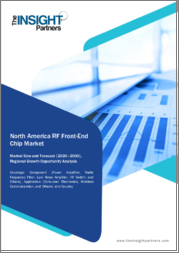
|
시장보고서
상품코드
1820092
스몰셀 파워 앰프 시장 보고서 : 유형별, 카테고리별, 용도별, 지역별(2025-2033년)Small Cell Power Amplifier Market Report by Type, Category, Application, and Region 2025-2033 |
||||||
세계 스몰셀 파워 앰프 시장 규모는 2024년 59억 달러에 달했습니다. 향후 IMARC Group은 2033년에는 234억 달러에 달할 것으로 예상하며, 2025년부터 2033년까지 15.84%의 연평균 성장률(CAGR)을 보일 것으로 예측했습니다. 모바일 기기 사용자 증가, 무선 인프라의 발전, 방대한 데이터 생성 등이 시장을 이끄는 주요 요인으로 작용하고 있습니다.
스몰셀 파워 앰프는 네트워크에서 무선 주파수(RF) 신호의 전력을 증폭하는 데 사용되는 전자기기입니다. 신호 강도를 높이고, 네트워크 커버리지를 확대합니다. 또한, 3G, 4G, 5G 네트워크 등 다양한 주파수 대역의 데이터 전송 속도를 향상시킵니다. 또한, 신호가 더 멀리 도달할 수 있어 커버리지와 용량이 향상됩니다. 기존 셀 타워보다 더 작고 비용 효율적입니다. 효율이 높고 에너지 소비와 발열이 적어 운영비 절감과 장비 수명 연장에 기여합니다. 그 결과, 스몰셀 파워 앰프는 전 세계 스몰셀 기지국, 터미널이 있는 데이터 카드, 파워앰프 구동 장치, 광대역 계측기에 널리 채택되고 있습니다.
스몰셀 파워 앰프 시장 동향:
급속한 디지털화와 초고속 인터넷의 보급으로 방대한 양의 데이터가 생성되고 데이터 트래픽이 증가하고 있습니다. 이는 스마트폰, 노트북, 태블릿 등 모바일 기기의 확산과 함께 전 세계적으로 다양한 기종의 혼합 및 업그레이드된 네트워크 품질에 대한 요구를 불러일으키는 중요한 요인 중 하나가 되고 있습니다. 또한, 무선 장비에 대한 수요 증가는 네트워크 용량및 범위 확대에 대한 수요를 촉진하고 있습니다. 또한, 고속, 저지연 연결성을 제공하기 위해 더 많은 스몰셀 기지국을 필요로 하는 5G 네트워크의 구축은 전 세계 시장에 긍정적인 영향을 미치고 있습니다. 이와는 별도로, 신뢰할 수 있고 비용 효율적인 연결성을 필요로 하는 산업화의 발전과 사물인터넷(IoT)의 채택 확대는 주요 시장 기업에게 유리한 성장 기회를 제공합니다. 또한, 신호 강도가 낮아 통신에 장애가 있는 오피스 빌딩, 컨벤션 센터, 공항 등의 인프라가 개선되고 고품질 전송에 대한 요구가 높아지는 것도 스몰셀 파워 앰프 수요를 자극하고 있습니다. 또한 Wi-Fi 라우터, 스마트 가전, IoT 센서 등 실내 무선 기기의 채택이 증가하고 있는 것도 요인 중 하나입니다. 또한, 각국 정부는 연결성 향상을 위해 지역 요금 제한, 연구개발(R&D) 활동 자금 지원 등 지방 및 서비스 소외 지역의 스몰셀 네트워크 구축을 촉진하기 위해 유리한 정책을 시행하고 있습니다. 또한, 설치에 대한 세제 혜택도 마련되어 있어 세계 시장의 성장을 가속하고 있습니다.
본 보고서에서 다룬 주요 질문
- 2025년부터 2033년까지 전 세계 스몰셀 파워 앰프 시장의 예상 성장률은?
- 스몰셀 파워 앰프 세계 시장을 이끄는 주요 요인은 무엇인가?
- COVID-19가 스몰셀 파워 앰프 세계 시장에 미치는 영향은?
- 스몰셀 파워 앰프 세계 시장 유형별 분류는?
- 스몰셀 파워 앰프 세계 시장 용도별 분류는?
- 스몰셀 파워 앰프 세계 시장 내 주요 지역은?
- 스몰셀 파워 앰프 세계 시장 내 주요 기업은?
목차
제1장 서문
제2장 조사 범위와 조사 방법
- 조사 목적
- 이해관계자
- 데이터 소스
- 1차 정보
- 2차 정보
- 시장 추정
- 상향식 접근
- 하향식 접근
- 조사 방법
제3장 주요 요약
제4장 소개
제5장 세계의 스몰셀 파워 앰프 시장
- 시장 개요
- 시장 실적
- COVID-19의 영향
- 시장 예측
제6장 시장 내역 : 유형별
- 27.5 데시벨
- 32 데시벨
- 36 데시벨
- 39 데시벨
- 기타
제7장 시장 내역 : 카테고리별
- 펨토셀
- 피코셀
- 마이크로셀
제8장 시장 내역 : 용도별
- 스몰셀 기지국
- 터미널 탑재 데이터 카드
- 파워 앰프 드라이버
- 광대역 계측 기기
- 기타
제9장 시장 내역 : 지역별
- 북미
- 미국
- 캐나다
- 아시아태평양
- 중국
- 일본
- 인도
- 한국
- 호주
- 인도네시아
- 기타
- 유럽
- 독일
- 프랑스
- 영국
- 이탈리아
- 스페인
- 러시아
- 기타
- 라틴아메리카
- 브라질
- 멕시코
- 기타
- 중동 및 아프리카
제10장 SWOT 분석
제11장 밸류체인 분석
제12장 Porter's Five Forces 분석
제13장 가격 분석
제14장 경쟁 구도
- 시장 구조
- 주요 기업
- 주요 기업 개요
- Broadcom Inc.
- Huawei Technologies Co. Ltd.
- II-VI Incorporated
- NXP Semiconductors N.V.
- Qorvo Inc
- Qualcomm Incorporated
- RFHIC Corporation
- Skyworks Solutions Inc.
- TEKTELIC Communications Inc.
- Texas Instruments Incorporated
The global small cell power amplifier market size reached USD 5.9 Billion in 2024. Looking forward, IMARC Group expects the market to reach USD 23.4 Billion by 2033, exhibiting a growth rate (CAGR) of 15.84% during 2025-2033. The increasing number of mobile device users, the developing wireless infrastructure, and the generation of excessive amounts of data represent some of the key factors driving the market.
A small cell power amplifier is an electronic device used to amplify the power of a radio frequency (RF) signal in networks. It enhances the strength of the signals and extends the network coverage. It also improves the rate of data transmission for different spectrums, such as 3G, 4G, and 5G networks. Moreover, it helps the signals to travel further and provide better coverage and capacity. It is smaller and more cost-effective than traditional cell towers. It is highly efficient, consumes less energy, and generates less heat, which assists in reducing operating costs and extending the lifespan of the equipment. As a result, small cell power amplifier is widely employed in small cell base stations, data cards with terminals, power amplifier drivers, and wideband instrumentation across the globe.
Small Cell Power Amplifier Market Trends:
Rapid digitization and increasing penetration of high-speed internet are generating an enormous amount of data and resulting in high data traffic. This, in confluence with the increasing adoption of mobile devices, such as smartphones, laptops, and tablets, represent one of the key factors catalyzing the need for heterogeneous and upgraded network quality across the globe. In addition, the escalating demand for wireless devices is propelling the demand for expanding network capacity and coverage. Moreover, the deployment of 5G networks, which require more small cell base stations to provide high-speed and low-latency connectivity, is positively influencing the market around the world. Apart from this, the rising industrialization and increasing adoption of the internet of things (IoT) that require reliable and cost-effective connectivity are offering lucrative growth opportunities to key market players. Additionally, improving infrastructure and increasing demand for high-quality transmission in office buildings, convention centers, and airports, wherein communication gets damaged due to low signal strength is catalyzing the demand for small cell power amplifier. It can also be attributed to the growing adoption of indoor wireless devices, such as Wi-Fi routers, smart home appliances, and IoT sensors. Furthermore, governments of various countries are undertaking favorable initiatives, such as limiting local fees and funding for research and development activities, to promote the deployment of small cell networks in rural and underserved areas for improving connectivity. They are also providing tax incentives for installation, which is stimulating the growth of the market worldwide.
Key Market Segmentation:
Type Insights:
- 27.5 dB
- 32 dB
- 36 dB
- 39 dB
- Others
Category Insights:
- Femtocell
- Picocell
- Microcell
Application Insights:
- Small Cell Base Stations
- Datacards with Terminals
- Power Amplifier Drivers
- Wideband Instrumentation
- Others
Regional Insights:
- North America
- United States
- Canada
- Asia-Pacific
- China
- Japan
- India
- South Korea
- Australia
- Indonesia
- Others
- Europe
- Germany
- France
- United Kingdom
- Italy
- Spain
- Russia
- Others
- Latin America
- Brazil
- Mexico
- Others
- Middle East and Africa
- The report has also provided a comprehensive analysis of all the major regional markets, which include North America (the United States and Canada); Asia Pacific (China, Japan, India, South Korea, Australia, Indonesia, and others); Europe (Germany, France, the United Kingdom, Italy, Spain, Russia, and others); Latin America (Brazil, Mexico, and others); and the Middle East and Africa. According to the report, North America (the United States and Canada) was the largest market for small cell power amplifier. Some of the factors driving the North America small cell power amplifier market included the huge data traffic, high number of mobile device users, wireless infrastructure, etc.
Competitive Landscape:
- The report has also provided a comprehensive analysis of the competitive landscape in the global small cell power amplifier market. Competitive analysis such as market structure, market share by key players, player positioning, top winning strategies, competitive dashboard, and company evaluation quadrant has been covered in the report. Also, detailed profiles of all major companies have been provided. Some of the companies covered include Broadcom Inc., Huawei Technologies Co. Ltd., II-VI Incorporated, NXP Semiconductors N.V., Qorvo Inc, Qualcomm Incorporated, RFHIC Corporation, Skyworks Solutions Inc., TEKTELIC Communications Inc., Texas Instruments Incorporated., etc. Kindly note that this only represents a partial list of companies, and the complete list has been provided in the report.
Key Questions Answered in This Report
- 1.What is the expected growth rate of the global small cell power amplifier market during 2025-2033?
- 2.What are the key factors driving the global small cell power amplifier market?
- 3.What has been the impact of COVID-19 on the global small cell power amplifier market?
- 4.What is the breakup of the global small cell power amplifier market based on the type?
- 5.What is the breakup of the global small cell power amplifier market based on the application?
- 6.What are the key regions in the global small cell power amplifier market?
- 7.Who are the key players/companies in the global small cell power amplifier market?
Table of Contents
1 Preface
2 Scope and Methodology
- 2.1 Objectives of the Study
- 2.2 Stakeholders
- 2.3 Data Sources
- 2.3.1 Primary Sources
- 2.3.2 Secondary Sources
- 2.4 Market Estimation
- 2.4.1 Bottom-Up Approach
- 2.4.2 Top-Down Approach
- 2.5 Forecasting Methodology
3 Executive Summary
4 Introduction
- 4.1 Overview
- 4.2 Key Industry Trends
5 Global Small Cell Power Amplifier Market
- 5.1 Market Overview
- 5.2 Market Performance
- 5.3 Impact of COVID-19
- 5.4 Market Forecast
6 Market Breakup by Type
- 6.1 27.5 dB
- 6.1.1 Market Trends
- 6.1.2 Market Forecast
- 6.2 32 dB
- 6.2.1 Market Trends
- 6.2.2 Market Forecast
- 6.3 36 dB
- 6.3.1 Market Trends
- 6.3.2 Market Forecast
- 6.4 39 dB
- 6.4.1 Market Trends
- 6.4.2 Market Forecast
- 6.5 Others
- 6.5.1 Market Trends
- 6.5.2 Market Forecast
7 Market Breakup by Category
- 7.1 Femtocell
- 7.1.1 Market Trends
- 7.1.2 Market Forecast
- 7.2 Picocell
- 7.2.1 Market Trends
- 7.2.2 Market Forecast
- 7.3 Microcell
- 7.3.1 Market Trends
- 7.3.2 Market Forecast
8 Market Breakup by Application
- 8.1 Small Cell Base Stations
- 8.1.1 Market Trends
- 8.1.2 Market Forecast
- 8.2 Datacards with Terminals
- 8.2.1 Market Trends
- 8.2.2 Market Forecast
- 8.3 Power Amplifier Drivers
- 8.3.1 Market Trends
- 8.3.2 Market Forecast
- 8.4 Wideband Instrumentation
- 8.4.1 Market Trends
- 8.4.2 Market Forecast
- 8.5 Others
- 8.5.1 Market Trends
- 8.5.2 Market Forecast
9 Market Breakup by Region
- 9.1 North America
- 9.1.1 United States
- 9.1.1.1 Market Trends
- 9.1.1.2 Market Forecast
- 9.1.2 Canada
- 9.1.2.1 Market Trends
- 9.1.2.2 Market Forecast
- 9.1.1 United States
- 9.2 Asia-Pacific
- 9.2.1 China
- 9.2.1.1 Market Trends
- 9.2.1.2 Market Forecast
- 9.2.2 Japan
- 9.2.2.1 Market Trends
- 9.2.2.2 Market Forecast
- 9.2.3 India
- 9.2.3.1 Market Trends
- 9.2.3.2 Market Forecast
- 9.2.4 South Korea
- 9.2.4.1 Market Trends
- 9.2.4.2 Market Forecast
- 9.2.5 Australia
- 9.2.5.1 Market Trends
- 9.2.5.2 Market Forecast
- 9.2.6 Indonesia
- 9.2.6.1 Market Trends
- 9.2.6.2 Market Forecast
- 9.2.7 Others
- 9.2.7.1 Market Trends
- 9.2.7.2 Market Forecast
- 9.2.1 China
- 9.3 Europe
- 9.3.1 Germany
- 9.3.1.1 Market Trends
- 9.3.1.2 Market Forecast
- 9.3.2 France
- 9.3.2.1 Market Trends
- 9.3.2.2 Market Forecast
- 9.3.3 United Kingdom
- 9.3.3.1 Market Trends
- 9.3.3.2 Market Forecast
- 9.3.4 Italy
- 9.3.4.1 Market Trends
- 9.3.4.2 Market Forecast
- 9.3.5 Spain
- 9.3.5.1 Market Trends
- 9.3.5.2 Market Forecast
- 9.3.6 Russia
- 9.3.6.1 Market Trends
- 9.3.6.2 Market Forecast
- 9.3.7 Others
- 9.3.7.1 Market Trends
- 9.3.7.2 Market Forecast
- 9.3.1 Germany
- 9.4 Latin America
- 9.4.1 Brazil
- 9.4.1.1 Market Trends
- 9.4.1.2 Market Forecast
- 9.4.2 Mexico
- 9.4.2.1 Market Trends
- 9.4.2.2 Market Forecast
- 9.4.3 Others
- 9.4.3.1 Market Trends
- 9.4.3.2 Market Forecast
- 9.4.1 Brazil
- 9.5 Middle East and Africa
- 9.5.1 Market Trends
- 9.5.2 Market Breakup by Country
- 9.5.3 Market Forecast
10 SWOT Analysis
- 10.1 Overview
- 10.2 Strengths
- 10.3 Weaknesses
- 10.4 Opportunities
- 10.5 Threats
11 Value Chain Analysis
12 Porters Five Forces Analysis
- 12.1 Overview
- 12.2 Bargaining Power of Buyers
- 12.3 Bargaining Power of Suppliers
- 12.4 Degree of Competition
- 12.5 Threat of New Entrants
- 12.6 Threat of Substitutes
13 Price Analysis
14 Competitive Landscape
- 14.1 Market Structure
- 14.2 Key Players
- 14.3 Profiles of Key Players
- 14.3.1 Broadcom Inc.
- 14.3.1.1 Company Overview
- 14.3.1.2 Product Portfolio
- 14.3.1.3 Financials
- 14.3.1.4 SWOT Analysis
- 14.3.2 Huawei Technologies Co. Ltd.
- 14.3.2.1 Company Overview
- 14.3.2.2 Product Portfolio
- 14.3.3 II-VI Incorporated
- 14.3.3.1 Company Overview
- 14.3.3.2 Product Portfolio
- 14.3.3.3 Financials
- 14.3.4 NXP Semiconductors N.V.
- 14.3.4.1 Company Overview
- 14.3.4.2 Product Portfolio
- 14.3.4.3 Financials
- 14.3.4.4 SWOT Analysis
- 14.3.5 Qorvo Inc
- 14.3.5.1 Company Overview
- 14.3.5.2 Product Portfolio
- 14.3.5.3 Financials
- 14.3.5.4 SWOT Analysis
- 14.3.6 Qualcomm Incorporated
- 14.3.6.1 Company Overview
- 14.3.6.2 Product Portfolio
- 14.3.6.3 Financials
- 14.3.6.4 SWOT Analysis
- 14.3.7 RFHIC Corporation
- 14.3.7.1 Company Overview
- 14.3.7.2 Product Portfolio
- 14.3.7.3 Financials
- 14.3.8 Skyworks Solutions Inc.
- 14.3.8.1 Company Overview
- 14.3.8.2 Product Portfolio
- 14.3.8.3 Financials
- 14.3.8.4 SWOT Analysis
- 14.3.9 TEKTELIC Communications Inc.
- 14.3.9.1 Company Overview
- 14.3.9.2 Product Portfolio
- 14.3.10 Texas Instruments Incorporated
- 14.3.10.1 Company Overview
- 14.3.10.2 Product Portfolio
- 14.3.10.3 Financials
- 14.3.10.4 SWOT Analysis
- 14.3.1 Broadcom Inc.



















